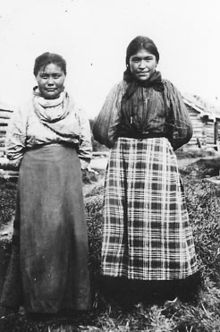


Slavey girls, Mackenzie River, Northwest Territories
| |
| Total population | |
|---|---|
| 2,630 (2016 census)[1] | |
| Regions with significant populations | |
| Canada (Northwest Territories, Alberta) | |
| Languages | |
| North and South Slavey language | |
| Religion | |
| Animism | |
| Related ethnic groups | |
| Sahtu (North Slavey) |
The Slavey (also Slave and South Slavey) are a First Nations indigenous peoples of the Dene group, indigenous to the Great Slave Lake region, in Canada's Northwest Territories, and extending into northeastern British Columbia and northwestern Alberta.
Slavey or just Slave is a translation of Awokanak,[2] the name given to Dene by the Cree "who sometimes raided and enslaved their less aggressive northern neighbors".[3][4][5] The names of the Slave River, Lesser Slave River, Great Slave Lake, and Lesser Slave Lake all derive from this Cree name. Esclaves remains incorporated in the French names of these geographical features, since the French traded with the Cree before the English did. The people now called Slavey in English were not necessarily taken as slaves in that period.
The name Slavey is seldom used by the people themselves, who call themselves Dene. Indigenous ethnonyms for South Slavey people and language are Dehcho, Deh Cho Dene ("Mackenzie River People") or Dene Tha.[6]
Though most Athabaskan peoples call themselves Dene, those in the Northwest Territories tend to use it for their particular group specifically. However, the northern Slavey are also known in English as the Sahtú, while the southern band are known as the Deh Cho.[7]
The South Slavey live in northwestern Alberta, northeastern British Columbia, and the southern Northwest Territories. First Nations of South Slavey people:[8]
The Sahtu, Sahtu Dene ("Great Bear Lake People") or North Slavey people live exclusively in the Northwest Territories. They speak the North Slavey language.
The Navajo people (Diné) of the Four Corners region of the Southwestern United States are said to be descended from the Nahani, who lived where the Nahanni National Park Reserve is, and also the Slavey of Northern Canada.[12]
Most residents of Lynx River, the fictional town in which CBC drama North of 60 is set, are Slavey. Though the word itself is seldom mentioned in dialogue (band members generally identifying themselves as Dene), the town is located in Slavey territory and on one occasion a character proposes a toast before the assembled members in the Slavey language.[citation needed]
|
| |||||||||||||||||||||||||||||
|---|---|---|---|---|---|---|---|---|---|---|---|---|---|---|---|---|---|---|---|---|---|---|---|---|---|---|---|---|---|
| Ethnolinguistic groups (by language family) |
| ||||||||||||||||||||||||||||
| Historical polities |
| ||||||||||||||||||||||||||||
| Numbered Treaties |
| ||||||||||||||||||||||||||||
| Tribal councils and band governments |
| ||||||||||||||||||||||||||||
| |||||||||||||||||||||||||||||
| Authority control databases: National |
|
|---|